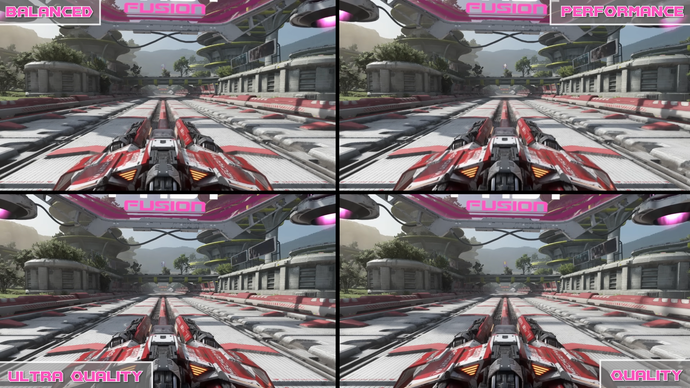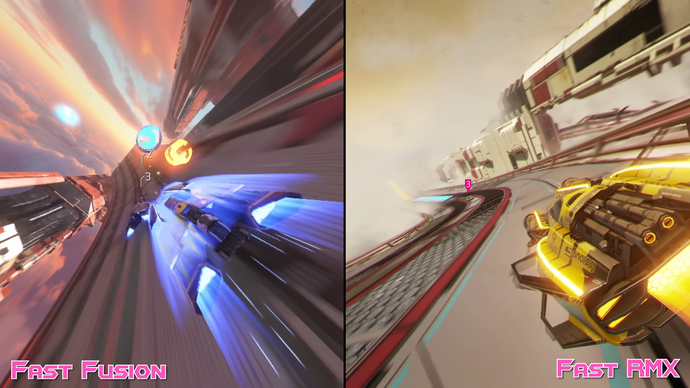While many of Switch 2‘s launch games are merely ports of existing games, the platform currently excels in one key area – racing games. For my money, there’s nothing better than a system launch packed full of arcade racing action and, in that sense, Switch 2 doesn’t disappoint. Mario Kart World is the system’s biggest title, while the original arcade version of Ridge Racer also makes its appearance – finally another system launch with a Ridge Racer game! Yet perhaps the most impressive racer on the system thus far, and also one of the most enjoyable games period, is Fast Fusion from Shin’en Multimedia.
We’ve featured Shin’en’s work on Digital Foundry many times over, most recently The Touryst, and for good reason: this Munich-based team has continued to produce amazing, tightly designed games across multiple genres, all while maintaining an exceptionally small team.
Fast Fusion is a proper sequel to the original Switch’s Fast RMX and the Wii U’s Fast Racing Neo, offering new mechanics and massively enhanced visuals while aiming for a fluid 60fps. At the same time, the game looks weirdly pixelated, so I wanted to investigate this issue and determine what’s going on.
Launching on the original Switch with Fast RMX was an awesome choice by Shin’en but, ultimately, it was an enhanced and expanded port of Fast Racing Neo for Wii U – which, to be fair, few people probably played given the console’s lack of success. With Fast Fusion, however, we finally have a proper sequel to that game. All new tracks, new mechanics and the fusion concept work in tandem to create something very special and fun. However, it was the visuals that caught our attention, with modern rendering techniques producing a stunning experience at 60fps.
The biggest upgrades stem from fundamental changes to the lighting and materials model deployed in Shinen’s proprietary engine. It needed to be beautiful but also robust enough to handle the game’s enormous, high-speed tracks. More traditional light probe solutions were too memory-intensive – according to Shin’en, it would require upwards of 1GB of lighting data for just a single track. Furthermore, screen-space lighting alone wouldn’t be sufficient, as ambient and specular lighting were both necessary to pull off the look.
To solve this, they engineered a hybrid system – blending multiple lighting techniques with a mix of dynamic caching and a small amount of baked lighting data. Lighting data per track comes in at just 5 to 15MB total, while pre-calculation only needs 1 to 2 minutes per track. This means the game only needs around 120MB of baked lighting data in total, keeping the file size down to just 3.5GB in a proud Shin’en tradition.
There’s also an abundance of volumetric fog introduced in the game, basically simulating light scattering through the atmosphere. Volumetrics are usually rendered at much lower resolutions to maintain performance, especially on a bandwidth-constrained mobile system, but in Fast Fusion the devs were able to blend the 3D froxel volume rendered at a very low resolution with a screen-space upsampling pass to improve the fog. It’s impressively stable and even supports variable occlusion based on moving environmental details – so it is not static!
The performance implications are huge, with all lighting calculations being deferred and executed entirely on the GPU, so there’s zero CPU cost. Better still, the system scales linearly with resolution, so the lighting cost remains fixed at just 0.5ms whether you’re playing solo or in 4-player split screen.
However, it’s this scalability with resolution that connects us back to perhaps the game’s one visual foible – image quality. Shin’en has often deployed clever image quality tricks to squeeze more out of a piece of hardware. Fast Racing Neo, for instance, uses interlaced rendering while Fast RMX uses both dynamic resolution scaling and variable rate shading.
Fast Fusion, is a little different, with pixel counts during camera cuts revealing heavy DLSS upscaling. The 1080p mode seems to render around 540p, 1440p mode is weirdly slightly lower at 504p, while the 4K60 mode renders at roughly 648p. Portable mode seems slightly lower than this as well, though it only needs to upsample to a 1080p screen. The huge upscale factors needed to target a 4K screen cause the significant image break-up evident in the game’s fast-paced visuals. That’s the main weakness here, and in terms of raw pixel output, Fast RMX on the Switch actually runs at a higher resolution with more stable image quality.
The developers do seem aware of the issues with the DLSS presentation though, and a patch expected next week will add a “pure” mode that strips out DLSS in favour of a straight 1440p docked and 1080p handheld experience.

Regardless of the image quality concerns, the frame-rates on the four modes available now are excellent, with performance, balanced and quality modes all running at a near-locked 60fps, while the quality mode drops down to 30fps. Interestingly, the quality mode also disables real-time shadows in order to maximise resolution – a trade-off that’s not really worth it.
Beyond image quality, the rest of the visuals deserve plenty of praise. We already talked about lighting but the actual quality of the materials, the track detail and the ships are all wonderful. I love the subtle specular reflections on tracks with shiny or wet materials. The tracks themselves are also massively more detailed than anything in Fast RMX and the quality of the post-processing is improved as well, with sublime motion blur . Weather looks great too, with the rain and droplets forming on the screen looking suitably dramatic.
Fast Fusion also features an excellent HDR implementation, better distinction between highlights and darker regions of the image than Nintendo’s own games. In portable mode, this is limited by the screen, but on a proper HDR display, it really pops. All this is to say that, despite the chunky image quality, it is genuinely a stunning game and I still believe it’s the most technically impressive game of the launch lineup, due to its mix of high-quality visuals and fast performance.

Another aspect I wanted to briefly mention is the audio – Fast Fusion supports full surround sound, for starters, which is something that was relatively uncommon on the original Switch – hopefully we’ll see it more often this time. The sound work is really well done, and the music steals the show with proper high-energy electronic tracks that perfectly suit the action.
To wrap this up, though, let’s talk about the game. Now this is an interesting one because Nintendo has released F-Zero GX alongside the console via the GameCube NSO app. GX is one of the best futuristic racing games ever made, so how does Fast Fusion compete?
Well, fundamentally, while they’re both very fast, the core mechanics are rather different. Fusion focuses on a blue/orange mechanic that requires you to match your ship’s colour to the boost pads you hit, similar to Treasure’s Ikaruga. Adding the ability to jump to the mix makes the game so much more exciting, not only by allowing for more branching track designs and pickups in different locations, but introducing some risk/reward, as it’s easy to jump off the track or crash into a bridge.
All in all, though, even with its shortcomings, I think Fast Fusion is a must-have launch title for Switch 2. With so few choices in terms of actual new games, it’s a no-brainer, really.
